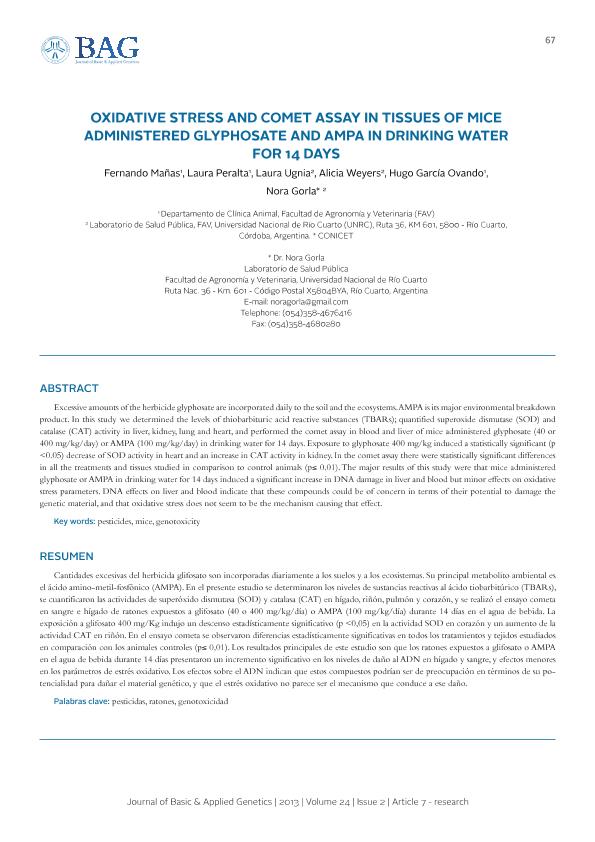Artículo
Excessive amounts of the herbicide glyphosate are incorporated daily to the soil and the ecosystems. AMPA is its major environmental breakdown product. In this study we determined the levels of thiobarbituric acid reactive substances (TBARs); quantified superoxide dismutase (SOD) and catalase (CAT) activity in liver, kidney, lung and heart, and performed the comet assay in blood and liver of mice administered glyphosate (40 or 400 mg/kg/day) or AMPA (100 mg/kg/day) in drinking water for 14 days. Exposure to glyphosate 400 mg/kg induced a statistically significant (p <0.05) decrease of SOD activity in heart and an increase in CAT activity in kidney. In the comet assay there were statistically significant differences in all the treatments and tissues studied in comparison to control animals (p≤0.01). The major results of this study were that mice administered glyphosate or AMPA in drinking water for 14 days induced a significant increase in DNA damage in liver and blood but minor effects on oxidative stress parameters. DNA effects on liver and blood indicate that these compounds could be of concern in terms of their potential to damage the genetic material, and that oxidative stress does not seem to be the mechanism causing that effect. Cantidades excesivas del herbicida glifosato son incorporadas diariamente a los suelos y a los ecosistemas. Su principal metabolito ambiental es el ácido amino-metil-fosfónico (AMPA). En el presente estudio se determinaron los niveles de sustancias reactivas al ácido tiobarbitúrico (TBARs), se cuantificaron las actividades de superóxido dismutasa (SOD) y catalasa (CAT) en hígado, riñón, pulmón y corazón, y se realizó el ensayo cometa en sangre e hígado de ratones expuestos a glifosato (40 o 400 mg/kg/día) o AMPA (100 mg/kg/día) durante 14 días en el agua de bebida. La exposición a glifosato 400 mg/Kg indujo un descenso estadísticamente significativo (p <0,05) en la actividad SOD en corazón y un aumento de la actividad CAT en riñón. En el ensayo cometa se observaron diferencias estadísticamente significativas en todos los tratamientos y tejidos estudiados en comparación con los animales controles (p≤ 0,01). Los resultados principales de este estudio son que los ratones expuestos a glifosato o AMPA en el agua de bebida durante 14 días presentaron un incremento significativo en los niveles de daño al ADN en hígado y sangre, y efectos menores en los parámetros de estrés oxidativo. Los efectos sobre el ADN indican que estos compuestos podrían ser de preocupación en términos de su potencialidad para dañar el material genético, y que el estrés oxidativo no parece ser el mecanismo que conduce a ese daño.
Oxidative stress and comer assa in tissues of mice administered glyphosate and ampa in drinking water for 14 days
Mañas, Fernando Javier ; Peralta, Laura; Ugnia, Laura; Weyers, Alicia; García Ovando, Hugo; Gorla, Nora Bibiana Maria
; Peralta, Laura; Ugnia, Laura; Weyers, Alicia; García Ovando, Hugo; Gorla, Nora Bibiana Maria
 ; Peralta, Laura; Ugnia, Laura; Weyers, Alicia; García Ovando, Hugo; Gorla, Nora Bibiana Maria
; Peralta, Laura; Ugnia, Laura; Weyers, Alicia; García Ovando, Hugo; Gorla, Nora Bibiana Maria
Fecha de publicación:
12/2013
Editorial:
Sociedad Argentina de Genética
Revista:
Journal of basic and applied genetics
ISSN:
1853-7138
Idioma:
Inglés
Tipo de recurso:
Artículo publicado
Clasificación temática:
Resumen
Archivos asociados
Licencia
Identificadores
Colecciones
Articulos(CCT - MENDOZA)
Articulos de CTRO.CIENTIFICO TECNOL.CONICET - MENDOZA
Articulos de CTRO.CIENTIFICO TECNOL.CONICET - MENDOZA
Citación
Mañas, Fernando Javier; Peralta, Laura; Ugnia, Laura; Weyers, Alicia; García Ovando, Hugo; et al.; Oxidative stress and comer assa in tissues of mice administered glyphosate and ampa in drinking water for 14 days; Sociedad Argentina de Genética; Journal of basic and applied genetics; 24; 2; 12-2013; 67-75
Compartir



